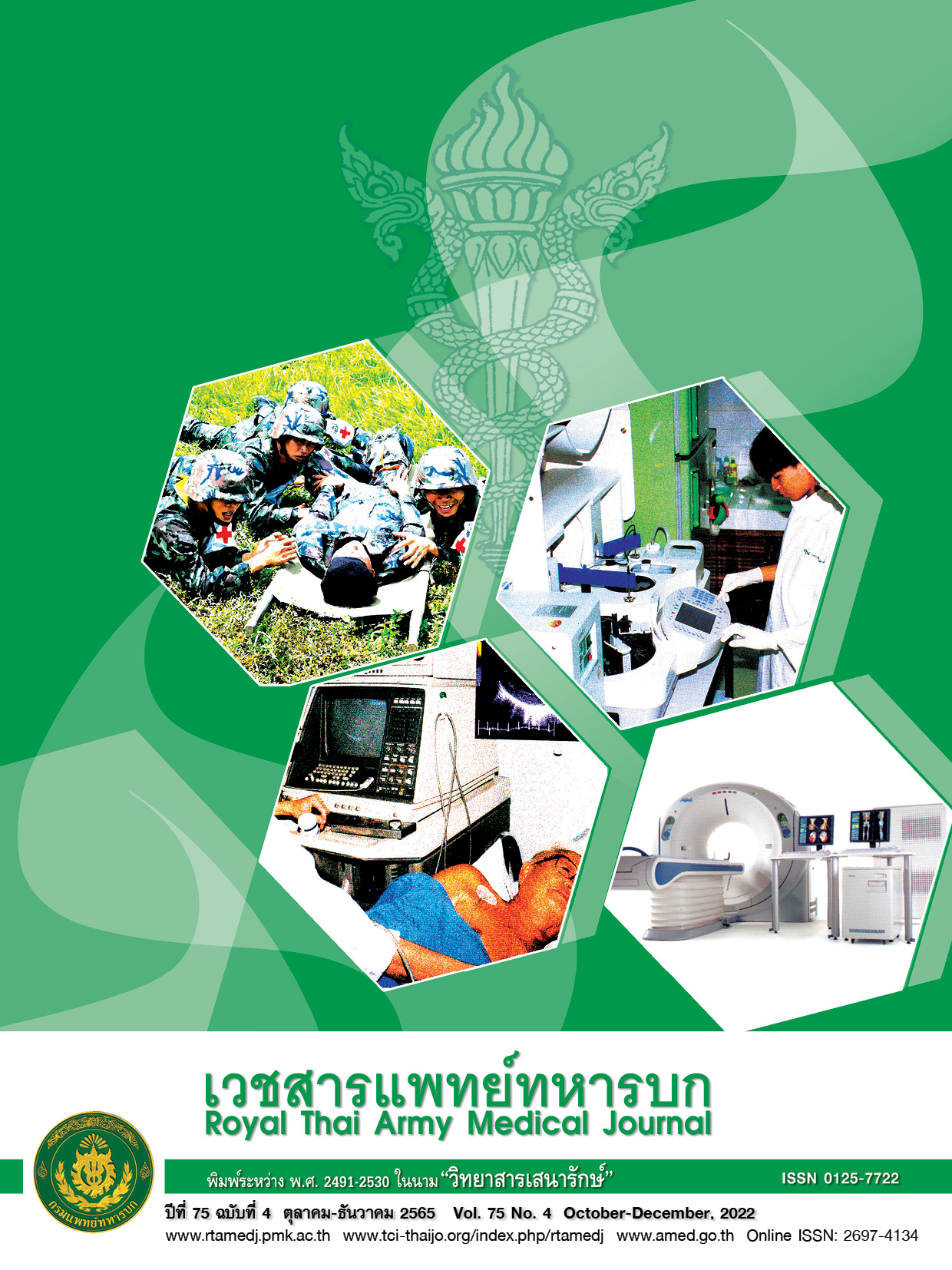ความคงตัวและภาวะปลอดเชื้อของยาหยอดตา 0.01% Atropine สำหรับผู้ป่วยเฉพาะราย
Main Article Content
บทคัดย่อ
วัตถุประสงค์: ในบริบทที่ไม่มียาผสม0.01%Atropine จำหน่าย การเตรียมยาเฉพาะรายถูกนำมาใช้เพื่อชะลอภาวะสายตาสั้น อย่างไรก็ดีข้อมูลด้านความคงตัวและภาวะปลอดเชื้อของยาเตรียมเฉพาะราย 0.01% Atropineยังเป็นที่ต้องคอยติดตามแม้จะถูกจัดเตรียมโดยวิธีปลอดเชื้อก็ตาม วัตถุประสงค์ของงานวิจัยเพื่อศึกษาถึงความคงตัวและภาวะปลอดเชื้อของยาเตรียมเฉพาะราย 0.01% Atropine ที่ระยะเวลา 90 วัน
ระเบียบวิธีการวิจัย: ยาเตรียมเฉพาะราย 0.01% Atropine ผสมจากยา 1% Atropine เข้ากับน้ำตาเทียมสองชนิดที่มีส่วนผสมของ hydroxypropyl methylcellulose และ polyethylene glycol ด้วยวิธีปลอดเชื้อมาตรฐาน การเก็บยาเตรียมเฉพาะที่ผสมเสร็จแล้วไว้ที่อุณหภูมิ 4 และ 25 องศาเซลเซียส ทำการศึกษาถึงความคงตัวและปราศจากเชื้อ ทุก 30 วัน คือวันที่ 0, 30, 60, 90 หลังผสมยา ความคงตัวของยาศึกษาโดยวิธี high performance liquid chromatography โดยวัดผลเป็นเปอร์เซ็นต์ของปริมาณยาที่คงเหลือเทียบกับวันที่เริ่มผสมยา ส่วนภาวะปลอดเชื้อวัดจากผลการเพาะเชื้อทั้งชนิดแบคทีเรียและเชื้อรา
ผลลัพธ์: ตลอดระยะเวลาการศึกษาไม่พบทั้งเชื้อแบคทีเรียและเชื้อราปนเปื้อนในกลุ่มทดลอง ยาเตรียมเฉพาะราย 0.01% Atropine ที่ผสมด้วย hydroxypropyl methylcellulose ที่ถูกเก็บที่อุณหภูมิ 4 และ 25 องศาเซลเซียสและ ที่ผสมด้วย polyethylene glycol ที่ถูกเก็บที่อุณหภูมิ 4 องศาเซลเซียสมีความคงตัวของยาตลอดการศึกษา และพบว่ายาเตรียมเฉพาะราย 0.01% Atropine ที่ผสมด้วย polyethylene glycol ที่ถูกเก็บที่อุณหภูมิ 25 องศาเซลเซียส มีการลดลงของปริมาณยา 20% เมื่อเทียบกับปริมาณยาเริ่มต้น
สรุป: ยาเตรียมเฉพาะราย 0.01% Atropine ที่ผสมด้วยยาน้ำตาเทียมมีภาวะปลอดเชื้อที่ระยะเวลา 90 วันหลังเตรียมยา อย่างไรก็ดีการเตรียมยาเฉพาะราย 0.01% Atropine ด้วยน้ำตาเทียมที่มีส่วนประกอบต่างชนิดกันรวมถึงอุณหภูมิที่เก็บรักษาที่ต่างกันมีผลต่อความคงตัวของยา
Downloads
Article Details

อนุญาตภายใต้เงื่อนไข Creative Commons Attribution-NonCommercial-NoDerivatives 4.0 International License.
บทความในวารสารนี้อยู่ภายใต้ลิขสิทธิ์ของ กรมแพทย์ทหารบก และเผยแพร่ภายใต้สัญญาอนุญาต Creative Commons Attribution-NonCommercial-NoDerivatives 4.0 International (CC BY-NC-ND 4.0)
ท่านสามารถอ่านและใช้งานเพื่อวัตถุประสงค์ทางการศึกษา และทางวิชาการ เช่น การสอน การวิจัย หรือการอ้างอิง โดยต้องให้เครดิตอย่างเหมาะสมแก่ผู้เขียนและวารสาร
ห้ามใช้หรือแก้ไขบทความโดยไม่ได้รับอนุญาต
ข้อความที่ปรากฏในบทความเป็นความคิดเห็นของผู้เขียนเท่านั้น
ผู้เขียนเป็นผู้รับผิดชอบต่อเนื้อหาและความถูกต้องของบทความของตนอย่างเต็มที่
การนำบทความไปเผยแพร่ซ้ำในรูปแบบสาธารณะอื่นใด ต้องได้รับอนุญาตจากวารสาร
เอกสารอ้างอิง
Saw S-M, Gazzard G, Shih-Yen EC, Chua W-H. Myopia and associated pathological complications (Internet). Vol. 25, Ophthalmic and Physiological Optics. Wiley; 2005. p. 381–91. Available from: http://dx.doi.org/10.1111/j.1475-1313.2005.00298.x.
Rudnicka AR, Kapetanakis VV, Wathern AK, Logan NS, Gilmartin B, Whincup PH, et al. Global variations and time trends in the prevalence of childhood myopia, a systematic review and quantitative meta-analysis: implications for aetiology and early prevention (Internet). Vol. 100, British Journal of Ophthalmology. BMJ; 2016. p. 882–90. Available from: http://dx.doi.org/10.1136/bjophthalmol-2015-307724
Holden BA, Fricke TR, Wilson DA, Jong M, Naidoo KS, Sankaridurg P, et al. Global Prevalence of Myopia and High Myopia and Temporal Trends from 2000 through 2050 (Internet). Vol. 123, Ophthalmology. Elsevier BV; 2016. p. 1036–42. Available from: http://dx.doi.org/10.1016/j.ophtha.2016.01.006
Walline JJ, Lindsley K, Vedula SS, Cotter SA, Mutti DO, Twelker JD. Interventions to slow progression of myopia in children (Internet). Cochrane Database of Systematic Reviews. Wiley; 2011. Available from: http://dx.doi.org/10.1002/14651858.CD004916.pub3
Fan DSP, Lam DSC, Chan CKM, Fan AH, Cheung EYY, Rao SK. Topical Atropine in Retarding Myopic Progression and Axial Length Growth in Children with Moderate to Severe Myopia: A Pilot Study (Internet). Vol. 51, Japanese Journal of Ophthalmology. Springer Science and Business Media LLC; 2007. p. 27–33. Available from: http://dx.doi.org/10.1007/s10384-006-0380-7
Lee J-J, Fang P-C, Yang I-H, Chen C-H, Lin P-W, Lin S-A, et al. Prevention of Myopia Progression with 0.05% Atropine Solution (Internet). Vol. 22, Journal of Ocular Pharmacology and Therapeutics. Mary Ann Liebert Inc; 2006. p. 41–6. Available from: http://dx.doi.org/10.1089/jop.2006.22.41
Fang P-C, Chung M-Y, Yu H-J, Wu P-C. Prevention of Myopia Onset with 0.025% Atropine in Premyopic Children (Internet). Vol. 26, Journal of Ocular Pharmacology and Therapeutics. Mary Ann Liebert Inc; 2010. p. 341–5. Available from: http://dx.doi.org/10.1089/jop.2009.0135
SHIH Y-F, CHEN C-H, CHOU A-C, HO T-C, LIN LL-K, HUNG P-T. Effects of Different Concentrations of Atropine on Controlling Myopia in Myopic Children (Internet). Vol. 15, Journal of Ocular Pharmacology and Therapeutics. Mary Ann Liebert Inc; 1999. p. 85–90. Available from: http://dx.doi.org/10.1089/jop.1999.15.85
Yen MY, Liu JH, Kao SC, Shiao CH. Comparison of the effect of atropine and cyclopentolate on myopia. Ann Ophthalmol. 1989 May;21(5):180-2, 187.
Chua W-H, Balakrishnan V, Chan Y-H, Tong L, Ling Y, Quah B-L, et al. Atropine for the Treatment of Childhood Myopia (Internet). Vol. 113, Ophthalmology. Elsevier BV; 2006. p. 2285–91. Available from: http://dx.doi.org/10.1016/j.ophtha.2006.05.062
Chia A, Chua W-H, Cheung Y-B, Wong W-L, Lingham A, Fong A, et al. Atropine for the Treatment of Childhood Myopia: Safety and Efficacy of 0.5%, 0.1%, and 0.01% Doses (Atropine for the Treatment of Myopia 2) (Internet). Vol. 119, Ophthalmology. Elsevier BV; 2012. p. 347–54. Available from: http://dx.doi.org/10.1016/j.ophtha.2011.07.031
Shih Y-F, Hsiao CK, Chen C-J, Chang C-W, Hung PT, Lin LL-K. An intervention trial on efficacy of atropine and multi-focal glasses in controlling myopic progression (Internet). Vol. 79, Acta Ophthalmologica Scandinavica. Wiley; 2001. p. 233–6. Available from: http://dx.doi.org/10.1034/j.1600-0420.2001.790304.x
Liang C-K, Ho T-Y, Li T-C, Hsu W-M, Li T-M, Lee Y-C, et al. A combined therapy using stimulating auricular acupoints enhances lower-level atropine eyedrops when used for myopia control in school-aged children evaluated by a pilot randomized controlled clinical trial (Internet). Vol. 16, Complementary Therapies in Medicine. Elsevier BV; 2008. p. 305–10. Available from: http://dx.doi.org/10.1016/j.ctim.2008.04.007
Cooper J, Schulman E, Jamal N. Current status on the development and treatment of myopia. Optometry. 2012 May 31;83(5):179-99.
Li S-M, Wu S-S, Kang M-T, Liu Y, Jia S-M, Li S-Y, et al. Atropine Slows Myopia Progression More in Asian than White Children by Meta-analysis (Internet). Vol. 91, Optometry and Vision Science. Ovid Technologies (Wolters Kluwer Health); 2014. p. 342–50. Available from: http://dx.doi.org/10.1097/OPX.0000000000000178
Pineles SL, Kraker RT, VanderVeen DK, Hutchinson AK, Galvin JA, Wilson LB, et al. Atropine for the Prevention of Myopia Progression in Children (Internet). Vol. 124, Ophthalmology. Elsevier BV; 2017. p. 1857–66. Available from: http://dx.doi.org/10.1016/j.ophtha.2017.05.032
Yam JC, Jiang Y, Tang SM, Law AKP, Chan JJ, Wong E, et al. Low-Concentration Atropine for Myopia Progression (LAMP) Study (Internet). Vol. 126, Ophthalmology. Elsevier BV; 2019. p. 113–24. Available from: http://dx.doi.org/10.1016/j.ophtha.2018.05.029
Chia A, Lu Q-S, Tan D. Five-Year Clinical Trial on Atropine for the Treatment of Myopia 2 (Internet). Vol. 123, Ophthalmology. Elsevier BV; 2016. p. 391–9. Available from: http://dx.doi.org/10.1016/j.ophtha.2015.07.004
Chia A, Chua W-H, Wen L, Fong A, Goon YY, Tan D. Atropine for the Treatment of Childhood Myopia: Changes after Stopping Atropine 0.01%, 0.1% and 0.5% (Internet). Vol. 157, American Journal of Ophthalmology. Elsevier BV; 2014. p. 451-457.e1. Available from: http://dx.doi.org/10.1016/j.ajo.2013.09.020
Moon JS, Shin SY. The diluted atropine for inhibition of myopia progression in Korean children. Int J Ophthalmol. 2018;11(10):1657-62.
Saito J, Imaizumi H, Yamatani A. Physical, chemical, and microbiological stability study of diluted atropine eye drops (Internet). Vol. 5, Journal of Pharmaceutical Health Care and Sciences. Springer Science and Business Media LLC; 2019. Available from: http://dx.doi.org/10.1186/s40780-019-0154-2


